Bel Canto CD2 CD Player and DAC3.5VB Mark II
|
Bel Canto CD2 CD Player |
|
The Return of the Mk II |
|
|
|
February, 2012 |
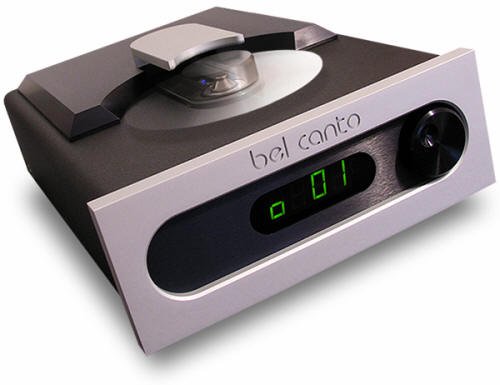
The opportunity arose a few months back to acquire a well-used, but kindly-treated, Bel Canto CD2 player. I had heard rumors that the CD2 and DAC3.5 combination was something special, so I anticipated this acquisition would prove a stroke of good fortune (though I could not have realistically anticipated how good). The CD2 arrived in the a highly-protective Bel Canto custom foam-lined box, showing no outward signs of its several years of travel and demonstration duty at various audio shows. It presented a unique appearance, quite different from any other CD player I’d seen.
Transport. The CD2 is a hefty (18 pound), half-rack-size package that matches the other four Bel Canto e.One components I own: the VBS1 (Virtual Battery Supply), DAC3.5VB, and a pair of REF1000 Mk II analog switching amplifiers. Down the road I may audition the CD2 in alternate configurations, as a stand-alone transport/DAC/preamp, and with the included in-line external switching power supply. But for starters, and for purposes of this report, I wanted to hear the unit at its theoretical best, as a transport only, feeding a DAC3.5VB powered by the Bel Canto VBS1 (which as I’ve remarked before has a lower residual noise level than a lead-acid battery!).
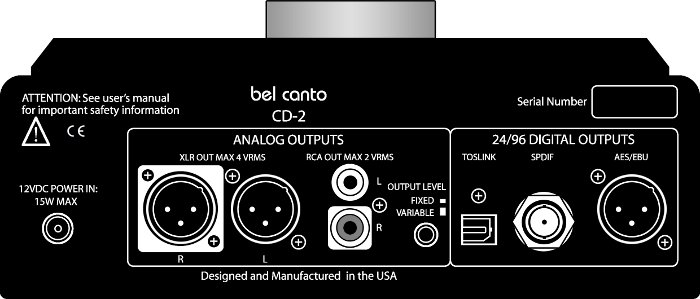
There are both digital and analog outputs on the rear of the CD2, and I disabled the latter by selecting “Variable” output with the rear pushbutton switch, cycling the analog output level to zero, then selecting “Fixed” output with the pushbutton. Using variable analog output involves — as it does in the DAC3.5 —complex dithering algorithms. I presume setting the analog output to zero effectively idles the components doing those calculations, as well as idling the analog output stages. This eliminates potential sources of noise.
The transport mechanism itself is a Philips CD-Pro2LF, the latest in a family of durable, professional-grade transport mechanisms with superior data retrieval capabilities. The Philips technical paper describes it as including a “…pre-amplifier which moves together with the optics on a sledge following the track. This ensures quality tracking signals as well as data signals for the data slicer and allows for a high quality ‘eye pattern’ with low jitter.” The “eye pattern” is made up of the output of the read head as seen on an oscilloscope. It is a reasonable assumption that superior data retrieval results in fewer read errors and fewer interpolations. Great care is taken in manufacturing the CD-Pro2LF to assure perfect alignment of the read head to the turntable. As well, the laser is run at the lowest power compatible with dependable reads to insure long life as well as reduced heat and jitter. When a disk is not being played, both the laser and the drive motor are idle. The CD-Pro2LF is designed to be able read through a finger print without error. (I once had a machine that could, literally, handle a 0.5mm black out with aplomb; the CD2 cannot, but I’m not certain if such extraordinary tracking capabilities involves certain trade-offs.) As a practical matter, I’ve had few problems with dirty CDs. It is also noteworthy that this drive is often used in commercial jukeboxes where reliability is a primary requirement. By the way, the “LF” in the name means simply that the mechanism complies with EU standards requiring the use of lead-free solder.
CD2 outputs include XLR and RCA for analog; XLR, BNC (w/ RCA adaptor) and Toslink for digital. There is a male socket for 12 VDC power, supplied by either the included in-line switching supply, or the VBS1. There is no power switch; the unit is designed to remain on full time. The front has a single control knob that controls start/pause/stop, volume (in variable analog mode), and track selection. The remote control has additional functions including numeric input, fast forward/reverse, display, time, and mute.
It may be worth noting the obvious at this juncture: the turntable and hence the CD itself is physically external to the CD2 chassis. The means the spinning CD is exposed to electromagnetic fields in the room (including light), but it also means the CD is not exposed to electromagnetic fields inside the chassis. The underside of the CD is within a fraction of an inch of the top of the steel chassis; correspondingly there is no metallic surface parallel with the top of the CD as there is with an internal drive; any laser beam scatter will disperse in the atmosphere rather than bouncing around inside a steel chassis, possibly striking the lens unpredictably. I make absolutely no speculation on how these factors may effect the sound (if at all) but they do constitute a unique physical environment, so I note them. Visitors to chez Lichter have been fascinated with a CD transport that looks rather like a miniature record player.
I retired my much heftier (45 pound) Accuphase to a lower shelf, set up the CD2 as described, plugged in my Wywires Silver cables, and put on a familiar CD, Mozart’s splendiferous Jeunehomme piano concerto played by Alfred Brendel with Sir Charles Mackerras conducting the Scottish Chamber Orchestra (Philips/Musical Heritage 5188425). What I heard—and I do want to be cautious with adjectives—was not what I expected to hear.
What I expected to hear, what common sense prepared me to hear, was sound pretty identical with or at least very close to what I was used to. After all, other than poor design or timing errors, it’s difficult to account for large sonic differences in S/PDIF output CD transports. And moreover, the DAC3.5 is specifically designed with source-immunity uppermost in mind. Jitter in? No problem. Then there’s the heart of the unit, the UltraClock circuit—0.0001% accurate with maximum 1 pS RMS jitter—retiming everything to the minutest fraction of a microsecond.
What I heard, however, was not even close to this expectation. Refined over the years, my stereo is pretty decent sounding, even by exalted audiophile standards. But the treble was airier, more nuanced and detailed; the bass seemed to reach distinctly lower with more body and authority; there was greater overall clarity, finer ambient detail; orchestral horns had a more realistic bite; there was an unambiguous and engaging rhythmic drive; imaging and sound staging were improved as well. These changes did not require concentration to detect, they were not in the least subtle, they were abundant and obvious.
As you can see from the photo, the CD2 is a simple and elegant design. It is visually beautiful and I think worthy of inclusion in the Industrial Design collection of the Museum of Modern Art. You put a CD on the spindle, place a polished stainless-steel magnetic puck over it and press Play (or one of the numeric buttons) — endearingly reminiscent of the ceremony involved in playing vinyl. As a practical matter, the read head is exposed to dust and, heaven forefend, the predations of awkward fingers. Standard designs almost universally employ a CD tray, motors and belts to move the tray in and out for loading and unloading, and, in high-priced units like the Accuphase, mechanisms to clamp and stabilize the tray to prevent resonant vibrations during play. All of this is dispensed with in the CD2. As for the issue of dust, the instruction manual promises that most of this is handled by the air turbulence of the rotating disk. It suggests leaving a CD in place to help prevent the entrance of dust. As well there are special fluids and devices for cleaning CD lenses. Me, I keep the little beauty covered with a piece of cloth to minimize the issue.
And while I’m on the subject, four last quibbles: I like countdown timing, I like to know how much time is remaining on the track. The CD2 counts up only. I like to be able to see time and current track and total tracks at the same time. The CD2 shows either time, or current track; total tracks are displayed only at the start of play, and only if you’ve reset initialization by pressing Play with no disk in place. And I like dimmable displays; the CD2 is either on or off (it goes brighter when a control button is pressed). Display is controlled by two buttons, one switching between track number, firmware revision number, and display off; the other between track number and elapsed time. Finally, and most significantly, the CD2 is not programmable.
Synergy. Synergy, according to the highest authority at my disposal, The Oxford English Dictionary, is “Increased effectiveness, achievement, etc., produced as a result of combined action or co-operation.” When the sum effectiveness of two components, in other words, is greater than could be predicted from the effectiveness of each. I have always avoided the word because it is used too often and too freely among audiophiles, and it can cloak what is not really understood in an illusory mantle of understanding. Nonetheless, as I noted, when I combined the CD2 with the DAC3.5 the result was far better than I anticipated and this phenomenon could fall under the synergistic rubric. Perhaps an engineer specializing in digital audio could suggest possible reasons for this, but I cannot. I can however marvel at a remarkable improvement in sound quality.
My Accuphase is noteworthy for massiveness, freedom from mechanical vibration, and very low specified jitter. And accepting that the DAC3.5 is largely immune to many of the data stream (S/PDIF) problems that afflict CD transports, it follows that the CD2 output stream must be (measurably?) different than that coming from my Accuphase because it sounds so different. Lower jitter? Fewer data interpolations? Fewer read errors? Fewer drop outs? Different way of handling error correction? Different buffering system? Even so, how can the elimination of these sporadic events account for a consistently gutsier and more robust bass, more clarity, the impression of greater delineation and articulation in the orchestral texture, bigger and airier image and sound stage? Perhaps it is a lower noise floor or a more accurate clock? Or perhaps the isolation transformers on the digital outputs? It is probably still a truism that the human ear is more sensitive than any test instrument. So even if something cannot be measured, that does not prove it is purely subjective in nature.
Not all reviews of the CD2 use Bel Canto ancillary gear, yet all of them praise its sound, observing that it sounds as good as machines costing two and three times its asking price. To me this implies that something beyond the “synergy” between the Bel Canto CD2 and Bel Canto DAC3.5 is at work, something about the CD2 itself that is outstanding to so many listeners, including those who don’t have a Bel Canto digital converter.
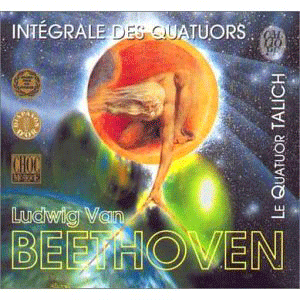 Beethoven: Complete String Quartets, Talich Quartet, (Calliope CAL 3633.9). The group, named after the legendary Moravian conductor Václav Talich, was my first set of Beethoven quartets, certain disks of which absolutely take the brass ring for “most realistic string quartet recording” in my collection. Absolutely stunning sound, some of them. And a level of musicianship quite unique and quite equal to any in my collection. Turning to this set of CDs is always a delight and a minor revelation, like rediscovering a gemstone on the kitchen counter. In addition to the limpid clarity and absolute ease and naturalness of the sound, one thing in particular caught my attention. In the slow movement of the Third Rasumovsky, Andante con moto quasi allegretto, there are very distinct details in the resonance of the ‘cello cavity I’ve not heard before. It’s a subtle thing, but it is also very exciting to hear this new dimension added to the personality of the violoncello. And here too the increased reach and bite of the bass line is evident.
Beethoven: Complete String Quartets, Talich Quartet, (Calliope CAL 3633.9). The group, named after the legendary Moravian conductor Václav Talich, was my first set of Beethoven quartets, certain disks of which absolutely take the brass ring for “most realistic string quartet recording” in my collection. Absolutely stunning sound, some of them. And a level of musicianship quite unique and quite equal to any in my collection. Turning to this set of CDs is always a delight and a minor revelation, like rediscovering a gemstone on the kitchen counter. In addition to the limpid clarity and absolute ease and naturalness of the sound, one thing in particular caught my attention. In the slow movement of the Third Rasumovsky, Andante con moto quasi allegretto, there are very distinct details in the resonance of the ‘cello cavity I’ve not heard before. It’s a subtle thing, but it is also very exciting to hear this new dimension added to the personality of the violoncello. And here too the increased reach and bite of the bass line is evident.
 Albéniz: Iberia, Espania, Recuerdos de viaji, Sonata No. 5, Estaban Sánchez, piano (Brilliant Classics 92398). This one might be a bit of a sticky wicket to explain. If I thought longer and harder about my reaction to this CD, I might be able to offer some fantastic account of my experience. No, maybe not. This may sound uncanny, but in certain ways it’s as if I’ve never heard this CD before. The piano sounds quite different than I remember from dozens of hearings with various components over the years. It is quite extraordinary. The piano is so much more nuanced and articulate that the sense of presence has gone up dramatically. The tone is richer and overtones are clearer. All perhaps a bit on the subtle side, but vitally important to the tactility of the musical experience. I could almost say I never before heard this Estaban Sánchez playing this piano. Is this one of those notorious subjective versus objective things? Spanish piano music is, by the by, what might be called an acquired taste. Not everybody cares for it. Richter never bothered, being content, in his own words, with Debussy. But Michel Block did, and Joyce Hatto did, and Estaban Sánchez did. How fortunate for me that a concert pianist friend introduced me to Iberia many years ago, and I fell in love with the music.
Albéniz: Iberia, Espania, Recuerdos de viaji, Sonata No. 5, Estaban Sánchez, piano (Brilliant Classics 92398). This one might be a bit of a sticky wicket to explain. If I thought longer and harder about my reaction to this CD, I might be able to offer some fantastic account of my experience. No, maybe not. This may sound uncanny, but in certain ways it’s as if I’ve never heard this CD before. The piano sounds quite different than I remember from dozens of hearings with various components over the years. It is quite extraordinary. The piano is so much more nuanced and articulate that the sense of presence has gone up dramatically. The tone is richer and overtones are clearer. All perhaps a bit on the subtle side, but vitally important to the tactility of the musical experience. I could almost say I never before heard this Estaban Sánchez playing this piano. Is this one of those notorious subjective versus objective things? Spanish piano music is, by the by, what might be called an acquired taste. Not everybody cares for it. Richter never bothered, being content, in his own words, with Debussy. But Michel Block did, and Joyce Hatto did, and Estaban Sánchez did. How fortunate for me that a concert pianist friend introduced me to Iberia many years ago, and I fell in love with the music.
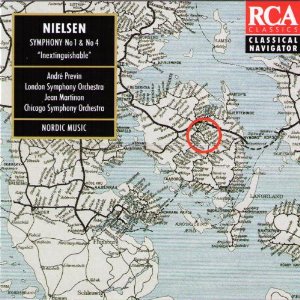 Carl Nielsen, Symphony No 1 and 4, Andre Previn, London SO; Jean Martinon, Chicago SO (RCA Classics 74321 21296 2). After a steady diet of Mozart for many weeks, I finally turned to a composer whose music I’ve long valued for its originality and for a streak of humility and sanity a mile wide, Carl Nielsen. Immensely healthy and vigorous. The Fourth Symphony, the Inextinguishable, is one of the best, brilliantly conducted by Jean Martinon. The sound quality is something wonderful, it has an understated, dynamic neutrality to be found only on rare CDs recorded by rare sound engineers, different from, but reminiscent of Mercury’s “Living Presence” sound. The ‘illusion of reality’ of the individual instruments and of the orchestral texture exceed most of the recordings in my library, and far exceed the level of reproduction I am accustomed to with my old Accuphase. To say it yet again, I am amazed at the difference a CD transport can make.
Carl Nielsen, Symphony No 1 and 4, Andre Previn, London SO; Jean Martinon, Chicago SO (RCA Classics 74321 21296 2). After a steady diet of Mozart for many weeks, I finally turned to a composer whose music I’ve long valued for its originality and for a streak of humility and sanity a mile wide, Carl Nielsen. Immensely healthy and vigorous. The Fourth Symphony, the Inextinguishable, is one of the best, brilliantly conducted by Jean Martinon. The sound quality is something wonderful, it has an understated, dynamic neutrality to be found only on rare CDs recorded by rare sound engineers, different from, but reminiscent of Mercury’s “Living Presence” sound. The ‘illusion of reality’ of the individual instruments and of the orchestral texture exceed most of the recordings in my library, and far exceed the level of reproduction I am accustomed to with my old Accuphase. To say it yet again, I am amazed at the difference a CD transport can make.
Interregnum. I discovered that using numeric access (pressing a track number rather than pressing “Play”) tends to clip the first fraction of a second with some CDs. As if the volume ramps up a fraction of a second too late. I contacted John Stronczer about this. Turns out the volume ramping functions have nothing to do with the CD2 but are internal to the DAC3.5 and that this behavior is a direct consequence of the manufacturer of a particular CD not following Redbook standards! Which is why it doesn’t happen with all CDs. A firmware update should solve this problem. I’ve just packed my DAC3.5VB for shipment to Minneapolis for firmware and power regulation upgrades. Which gives me the opportunity of using the CD2 with its internal DAC.
 Still using the VBS1 for power, I switched the CD2 analog output mode to variable, hooked the analogue XLR outputs directly to the REF1000s and popped on an early Mozart concerto (Geza Anda, pianist/conductor, Camerata Academica des Salzburger Mazarteums, Deutsche Grammophon 469 510-2). Differences between the internal DAC and the DAC3.5 were immediately to be heard, and I thought it important to record my initial impressions before I got used to the changes. There was some loss of airiness and finesse in the treble range, some loss of ambience, of tonal complexity and richness, some loss of bass depth and bite, some loss of body and presence, the strings didn’t sound quite so silky. All of which is just to say that the sound quality, while very good, was not as good as the CD2/DAC3.5VB combination.
Still using the VBS1 for power, I switched the CD2 analog output mode to variable, hooked the analogue XLR outputs directly to the REF1000s and popped on an early Mozart concerto (Geza Anda, pianist/conductor, Camerata Academica des Salzburger Mazarteums, Deutsche Grammophon 469 510-2). Differences between the internal DAC and the DAC3.5 were immediately to be heard, and I thought it important to record my initial impressions before I got used to the changes. There was some loss of airiness and finesse in the treble range, some loss of ambience, of tonal complexity and richness, some loss of bass depth and bite, some loss of body and presence, the strings didn’t sound quite so silky. All of which is just to say that the sound quality, while very good, was not as good as the CD2/DAC3.5VB combination.
Nonetheless, in the Mozart concertos the imaging was precise, the instruments crisp and articulate, the strings lush, the woodwinds sweet and nuanced, the soundstage broad and deep, hall ambience retrieval excellent. And as I had anticipated, I eventually ceased comparing — “Wasn’t the soundstage deeper with the DAC3.5?” — and simply found myself enjoying the music. And such music! I could easily live with a stereo of this caliber.
If there’s a conclusion to be drawn here, it’s that the quest for improvement is endless: for most of us there will always be amplifiers, converters, loudspeakers and wires that sound better (usually costing a lot more money than we can afford). In my opinion the CD2, combining a superior drive mechanism and a quality digital converter, represents excellent value. As for the solo CD2 sounding inferior to the CD2/DAC3.5VB combo, one cannot realistically expect a $3500 DAC to be included in a CD player selling for $2995!
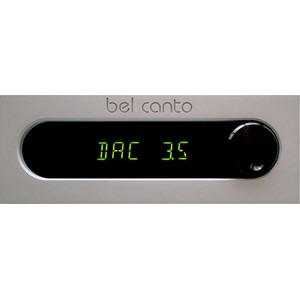
The DAC3.5VB Mark II returns. For those, like myself, interested in the specific changes wrought by Bel Canto on their already-superb DAC, these consist of an improved noise rejection ratio on the 5VDC supply for the analog section of the PCM1792 DAC chip, and a lower Phase Noise clock. “Phase noise,” states Wikipedia, “is the frequency domain representation of rapid, short-term, random fluctuations in the phase of a waveform, caused by time domain instabilities (“jitter).” Jitter is a term with which we are all familiar, and the clock is the very heart of any digital converter, the last place you want jitter. The DAC3.5VB MkII has a more stable, more accurate clock than its predecessor. Also in my experience over the years I’ve learned that the performance of the analog section of a converter is critical; regardless of how superb the digital performance. The end result of these several changes, as John Stronczer notes, “…is quite a stunning improvement.”
The one insuperable problem in reviewing a device upgrade is the necessity of relying on one’s memory of how it used to sound. (Unless, of course, you’re lucky enough to have a before and an after example on hand.) Auditory memory is not a long-term proposition, spanning minutes rather than weeks; at least those are the findings of the professionals in controlled laboratory tests. And in this case there is a two-fold problem. First, to recall how the DAC3.5VB sounded prior to its factory upgrade to Mk II status. Second, to extricate the intervening weeks with the CD2’s internal DAC from the sonic comparison.
I stated two paragraphs above that I could easily live with the CD2 sans DAC3.5 and I suppose if I could hold the perfectionist/audiophile aspect of my character at bay, that statement would still hold true. But the “new” DAC — unbroken-in as parts of it may be — is distinctly superior to the CD2’s internal DAC, and I am very glad that that particular privation is not on the board.
As well, to the best of my recollection, the new DAC demonstrates certain improvements over its previous incarnation. There is an enhanced substantiality to the instruments in the orchestra, they seem more solid in space. As if the image focus has become sharper, more defined and more tightly delineated. Ambient information blooms around the pianoforte with disarming immediacy. I particularly noticed how individual notes in a rapid arpeggio are more distinct. Details of hammer attack are stunningly revealed. And I do believe I am now hearing extreme subtleties as never before. Hearing ‘greater resolution’ is not a new experience, of course, and I don’t know how to quantify and distinguish it this time from all the other times, except to note yet again enhanced reality in musical reproduction, more tactility and presence. Words, of course, you’re read before! But the increase in musical pleasure is undeniable and unmistakable.

![]()
Product Info
Bel Canto Design, Ltd.
221 North 1st Street
Minneapolis MN 55401
USA
Bel Canto CD2 CD Player – Price: $2,995.00
Bel Canto DAC3.5VB MK II – Price: $3,495.00
Phone: Tel: 612-317-4550 (9AM to 5 PM CST M-F)
Toll-free (866) 200-7342
Fax: 612-359-9358
Website: www.belcantodesign.com
![]()
Don’t forget to bookmark us! (CTRL-SHFT-D)
Stereo Times Masthead
Publisher/Founder
Clement Perry
Editor
Dave Thomas
Senior Editors
Frank Alles, Mike Girardi, Key Kim, Russell Lichter, Terry London, Moreno Mitchell, Paul Szabady, Bill Wells, Mike Wright, Stephen Yan, and Rob Dockery
Current Contributors
David Abramson, Tim Barrall, Dave Allison, Ron Cook, Lewis Dardick, Dan Secula, Don Shaulis, Greg Simmons, Eric Teh, Greg Voth, Richard Willie, Ed Van Winkle, and Rob Dockery
Music Reviewers:
Carlos Sanchez, John Jonczyk, John Sprung and Russell Lichter
Site Management Clement Perry
Ad Designer: Martin Perry





Be the first to comment on: Bel Canto CD2 CD Player and DAC3.5VB Mark II